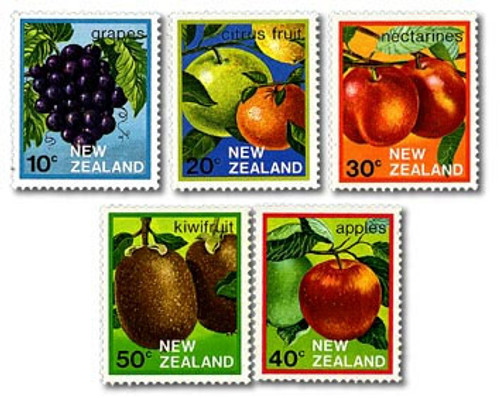The 1983 definitives issue included five stamps featuring fruit grown in New Zealand - grapes, citrus fruits, nectarines, apples and kiwifruit.
Issue information
Grapes featured on the 10c stamp and have been grown in New Zealand in Poverty Bay, Hawkes Bay, Malborough and Auckland. The growing of grapes for wine-making began in the earliest day of European Settlement in New Zealand. The first recorded grapes were planted by Samuel Marsden at Kerikeri, in the Bay of Islands.
Citrus fruit appeared on the 20c stamp - a tangelo, grapefruit and lemon. The tangelo's name is derived form two fruits - the tangerine and the pumelo - and probably originated in China and South Eastern Asia about 4,000 years ago. Grown throughout Northland, Bay of Plenty and the North Island's East Coast, the seminole tangleo is a tart-sweet fruit which grows in consistently heavy crops.
New Zealand's climate is not hot enough for the true grapefruit varieties of citrus paradisi, but the so-called grapefruit (or poorman's orange) tolerates the lower temperature well. This was named goldfruit in 1981 and it was the most important grapefruit type grown mainly in the Bay of Plenty. Predominant varieties of New Zealand lemons are the Villafranca and its close relative the Genoa, also grown mainly in the Bay of Plenty.
The 30c stamp featured two varieties of nectarines - Fantasia in the foreground and Red Gold behind. Grown mainly in Central Otago and Hawkes Bay, nectarines, like peaches have a rich golden skin with a crimson blush. However in contrast to the peach's soft furry skin, the nectarine is smooth.
Apples featured on the 40c stamp - the Granny Smith and Braeburn. Granny Smith apples originated in Australia, where a chance seedling was discovered in 1850 by none other than "Granny Smith". The Braeburn was developed in New Zealand. In 1983 about 90 per cent of apples were harvested in Nelson and Hawkes Bay, with the remainder grown mainly in Otago and Auckland.
Bay of Plenty which has warm sunny days and crisp nights provides an ideal natural environment for kiwifruit growing and New Zealand's first kiwifruit vines were established here. The kiwifruit's flavour is unique and although a tropical fruit, in some markets it joined the ranks of apples, oranges and pears as a popular fruit. Kiwifruit has a high vitamin C content with 105mg to every 100g of fruit.
Product Listing for 1983 Definitives - Fruit
Click on image to enlarge.
| Image | Title | Description | Price |
|---|---|---|---|
 |
Single Stamp |
Single 10c 'Grapes' gummed stamp. New Zealand's climate and soils are its key assets that enable it to produce outstanding table wines. Around the world, the finest wines are grown in regions with relatively cool climates where grapes are able to ripen fully but slowly, retaining their refreshing acidity while building up their most subtle aromas and flavours. New Zealand's 'cool climate' is its major viticultural advantage. |
$0.10 |
 |
Single Stamp |
Single 20c 'Citrus Fruit' gummed stamp. Three types of citrus fruit feature on this stamp - a tangelo, a grapefruit and a lemon. In 1982 New Zealand imported much of its citrus fruit requirements, but production of export tangelos and lemons was increasing. |
$0.20 |
 |
Single Stamp |
Single 30c 'Nectarines' gummed stamp. There have been several types of nectarines produced in New Zealand, and the Fantasia and the Red Gold varieties were featured on this stamp. These were amongst the four most important varieties produced in New Zealand, the others are Sun Glow and Delicious. |
$0.30 |
 |
Single Stamp |
Single 40c 'Apples' gummed stamp. In 1982 apples were New Zealand's second biggest export earner in horticulture. Granny Smith and a Braeburn varieties featured on the 40c stamp. |
$0.40 |
 |
Single Stamp |
Single 50c 'Kiwifruit' gummed stamp. The kiwifruit is one of New Zealand's most successful export products. In 1981 six million trays of kiwifruit were exported, making them an export earner. |
$0.50 |
 |
First Day Cover | First day cover with stamps affixed. Cancelled on the first day of issue. | $1.59 |
 |
Presentation Pack | Presentation pack containing a selection of stamp products from the issue and the 1982 Mineral Definitives and further information on the theme of the stamps. | $2.85 |
Technical information
| Date of issue: | 7 December 1983 |
|---|---|
| Number of stamps: | Five gummed stamps |
| Denominations: | 10c, 20c, 30c, 40c and 50c |
| Stamps and first day cover designed by: | D Little, Auckland, New Zealand |
| Printer and process: | Leigh-Mardon, Australia by lithography |
| Stamp size and format: | 25mm x 30mm (vertical) |
| Paper type: | Unwatermarked |
| Number of stamps per sheet: | 100 stamps per sheet |
| Perforation gauge: | 14.25 x 14 |
| Special blocks: | Plate/imprint blocks or value blocks may be obtained by purchasing at least 6 stamps of each denomination. |

